Tiago Forte's Blog, page 43
October 11, 2018
Tiago’s Life Goals
To read this story, become a Praxis member.

Praxis
You can choose to support Praxis with a subscription for $10 each month or $100 annually.
Members get access to:
1–3 exclusive articles per month, written or curated by Tiago Forte of Forte Labs
Members-only comments and responses
Early access to new online courses, ebooks, and events
A monthly Town Hall, hosted by Tiago and conducted via live videoconference, which can include open discussions, hands-on tutorials, guest interviews, or online workshops on productivity-related topics
Click here to learn more about what's included in a Praxis membership.
Already a member? Sign in here.
The post Tiago’s Life Goals appeared first on Praxis.
Os 5 Passos Para se Tornar uma Máquina de Produtividade (Interview in Portuguese)
I recently did my first interview in Portuguese, for the Growthcast podcast hosted by Max Peters. We talk about productivity, knowledge management, and then get pretty deep into personal growth as a path to personal effectiveness.
See a summary here, or listen below:
Subscribe to Praxis, our members-only blog exploring the future of productivity, for just $10/month. Or follow us for free content via Twitter, Facebook, LinkedIn, or YouTube.
The post Os 5 Passos Para se Tornar uma Máquina de Produtividade (Interview in Portuguese) appeared first on Praxis.
October 9, 2018
A Maker’s Ethos in the Era of Networked Attention
Once upon a time, we faced the scourge of Information Overload. Too many emails with too many details producing too many open loops to keep track of.
But now we have a new challenge: the Information Apocalypse. Not only is there far too much information to consume or manage, much of that information has now been weaponized. Whether it’s retargeted ads chasing us across the web, mobile apps designed for addiction, or emotionally charged news hitting us on every channel, it can often feel like we’re living in the informational end times.
But I believe that makers have something to offer the broader society in these dark days: an ethos that subordinates information consumption to the act of producing things of objective value. Being a maker today is a radical act. It means treasuring the insightful, the subtle, and the private, in a world that increasingly prizes only the novel, the sensational, and the public.
Being a maker requires patience when we’ve been trained to switch our focus constantly. It calls for reflection when we’ve been trained to react. It asks us to revisit an idea again and again until we’ve truly distilled its essence, instead of refreshing a feed for the newest of the new.
To read this story, become a Praxis member.

Praxis
You can choose to support Praxis with a subscription for $10 each month or $100 annually.
Members get access to:
1–3 exclusive articles per month, written or curated by Tiago Forte of Forte Labs
Members-only comments and responses
Early access to new online courses, ebooks, and events
A monthly Town Hall, hosted by Tiago and conducted via live videoconference, which can include open discussions, hands-on tutorials, guest interviews, or online workshops on productivity-related topics
Click here to learn more about what's included in a Praxis membership.
Already a member? Sign in here.
The post A Maker’s Ethos in the Era of Networked Attention appeared first on Praxis.
October 4, 2018
The Essential Requirements for Choosing a Notes App as Your Second Brain
I’ve argued strongly for the category of notes apps as the ideal home of your personal knowledge library, which I call a “second brain.”
I believe there are ten core capabilities that digital apps uniquely provide to the note-taking process:
Searchability: type in a few characters and see everything that matches, regardless of where it’s located
Duplication: duplicate your files, either to back them up, or create a new version while retaining the original
Access anywhere: keep files synchronized across devices, so you can access your files anywhere
Shareability: share a file with a friend or collaborator without losing your own copy
Editable: edit or change the content of your files, including the text, the formatting, the structure, and other elements
Upgradability: add or enhance functionality to your notes over time, as new features come out
Transferable: content can be moved from one place to another, through copy-and-paste for example
Linking: you can add clickable links, either to other files, or to external websites
Multimedia: save a wide variety of kinds of media, including text, images, videos, links, PDFs, and others
Meta-data: many pieces of data about your notes, such as location, date, device, and size, can be recorded automatically by software
Automation: certain kinds of content can be captured automatically, such as social media posts, emails, and web bookmarks
But this still leaves dozens of options, and it can be difficult to know exactly what the essential features look like. This article will describe what I believe to be the essential features for any app to serve effectively as your second brain, according to the methods I teach in my online course Building a Second Brain.
Here’s the summary:
Deal breakers
1. Quick capture and editing
2. Scales to thousands of notes without performance lag
3. Basic formatting options
4. Strong search feature
5. Ability to handle images and attachments
6. Private space, with public sharing
Must-haves
7. At least 3 levels of hierarchy
8. Many ways to capture information
9. Native and web versions
10. Capturing and syncing across multiple devices
11. Exportable as plain text
Nice-to-haves
12. Side-by-side viewing
13. Bullets or lists
14. Automatic date stamps
15. Tags
Deal breakers
1. Quick capture and editing
My most fundamental test of a knowledge capture app is whether, if you’re walking down the street and a brilliant (or wacky) idea suddenly pops into your mind, you will actually pull out your phone and capture it.
This is a common daily occurrence for photos, but not so much for ideas and insights. I can’t imagine this happening with Google Docs, or other heavy-duty text editing apps. One of the key strengths of notes apps is that they are made for just this kind of quick capture.
The same is true for editing – you need to be able to quickly find a note you’ve already saved, and opportunistically add, remove, or edit it, on a mobile device if necessary.
2. Scales to thousands of notes without performance lag
One of the critical principles for building a second brain is that each note should contain information from only one source. Instead of giant Microsoft Word or Google Docs documents, each note should be small and agile, so it can easily be mixed and matched with other notes.
This principle inevitably leads to creating thousands of notes in a relatively short amount of time. It’s very important that the collection can scale quickly, without performance lags.
3. Basic formatting options
Basic formatting options (such as bold, italics, underline, font colors, and highlighting) are an essential feature for quickly annotating text in a notes app. They are both very familiar for anyone who has done word processing, and customizable for those of us using specialized methods (such as my progressive summarization technique).
It doesn’t matter exactly which formatting options are available, but I recommend at least 3 distinct options that can be overlaid on top of each other (as in, a given passage can have more than one formatting style applied). I use bold, highlighting, and underlining, but any of these can easily be substituted for another style. What matters is that you use them consistently.
4. Strong search feature
With thousands of notes spanning hundreds of projects and topics, search is an essential feature of a notes app. Even with the powerful organizational methods I teach, it is often the very best way to go straight to the note you’re looking for.
It is essential that the search feature searches both the body of the note, as well as its title and meta-data. Ideally, the search feature also includes auto-complete (making suggestions as you type).
5. Ability to handle images and attachments
Although text tends to be the most common format for ideas, learnings, and observations, images are becoming a more and more important part of our creative vocabulary.
Your notes should be able to include images within the body of the note, not as an attachment that you have to click to view. This ensures that you will regularly come across them, serendipitously making new associations and connections.
Other kinds of files, such as videos, GIFs, PDFs, sound files, webpages, and others, should also be included, as attachments if necessary.
6. Private space, with public sharing
It’s important that your notes app serve as a private space for the ides that you’re not ready to share with the world. You should be able to jot down the most random thoughts, write out long personal reflections, sketch crazy harebrained schemes, all without the fear of criticism.
At the same time, it’s just as important that you have a way to share those ideas as soon as they’re ready for showtime. You can always copy and paste something to social media, of course, but ideally you’ll have a share feature integrated directly into the app you use. The less friction there is in sharing, the more often you’ll do it.
Must-haves
7. At least 3 levels of hierarchy
Although this is a strict requirement for my P.A.R.A. organizational method, I believe that in general at least 3 levels of hierarchy are needed for anyone to properly organize a large number of notes. In Evernote, the 3 levels are individual notes, which are contained in notebooks, which are contained in stacks. Other notes apps may use folders instead of notebooks, but the important thing is that you can put a group of related notes in one place, and they’ll stay there.
Numerous studies have shown that, despite the prevalence and effectiveness of search, people still overwhelmingly prefer to navigate through discrete containers to find their files. I believe this satisfies our sense of spatial awareness, and also provides many opportunities for serendipity (like wandering through the stacks of a library).
8. Many ways to capture information
Because we are using a notes app as a “universal inbox,” it is important that there are many different ways to get data into it.
Evernote, for example, has numerous options for importing content:
Web clipper (for capturing web pages)
Menu bar helper (for access through the computer menu bar)
Email capture (a customized email address you can forward emails to to be captured)
Mobile apps on popular platforms
Dropping files on dock icon (Mac only)
Copy and paste
Click and drag into a note
Third-party integrations (such as Bookcision for Kindle highlights, and IFTTT and Zapier for almost anything else)
Think about the 2 or 3 most common kinds of information you tend to save, and make sure you have a frictionless way to do so with the notes app you use.
9. Native and web versions
Many apps have gone web-first, meaning that they expect you to access them primarily through a web interface. This approach has many benefits, but it doesn’t work for notes apps. Your greatest enemy is friction, and the wait times for loading and reloading web pages are simply too long to keep up with creative ideation.
It is important that your notes app have a web version, to be able to access your notes from other computers, but your primary access will be through a native app. If there is also a native desktop app, this also allows offline access to your notes, and a way to save local backups.
10. Capturing and syncing across multiple devices
We live in a multi-device world, and this feature is now a must-have. You might capture most of your notes on a desktop computer, but having a mobile app for photos and videos will add a lot of richness and depth to your collection of notes. Reading ebooks on an iPad, I find that having my notes app just a few taps away is invaluable for capturing my ideas.
Although some apps allow you to set up sync manually, using third-party services, I don’t recommend it. Leave this technically complex task to the experts, even if you have to pay a monthly subscription.
11. Exportable as plain text
As heavily as I rely on formatting, I believe it is important to at least have an option for exporting notes as plain text. To protect against catastrophic data loss, the company going out of business, or simply because your needs change and a different app better suits your needs.
Plain text is the tool of last resort for getting your data out of a piece of software. These should be individual files, not a single, giant database record.
Nice-to-haves
12. Side-by-side viewing
This might seem overly specific, but is actually a crucial part of using your notes to do creative work. Being able to compare and contrast two notes, and move information between them if needed, is essential for creative synthesis. This can be accomplished through multiple panels, or by allowing you to open notes in separate windows.
13. Bullets or lists
Lists are one of the easiest ways to brainstorm and plan, and a natural fit for informal notes. Although a list can simply be a series of text entries without any particular structure, it’s helpful if there is a bullet, numbering, or list feature that makes it easy to create them.
14. Automatic date stamps
Within notebooks or folders, the best way to organize groups of notes is by their date of creation. Our brains naturally understand the flow of time, and often associate ideas with specific events or periods of time. Choose a notes app that automatically labels each note with the date.
15. Tags
Although I am a critic of using tags as a primary organizational system, they are still valuable. Your notes app should allow you to create and apply multiple tags to any given note, giving you an extra layer of control.
Subscribe to Praxis, our members-only blog exploring the future of productivity, for just $10/month. Or follow us for free content via Twitter, Facebook, LinkedIn, or YouTube.
The post The Essential Requirements for Choosing a Notes App as Your Second Brain appeared first on Praxis.
October 1, 2018
Introducing the MESA Method: Creating the Ideal Work Experience
For years I’ve written on this blog about new ways of working that allow people to bend time, space, and the human mind to their advantage.
How do I have the confidence to believe that a radically new and better way of working is possible?
Because I’ve experienced it, during what I call “accelerated work experiences,” or AWEs for short. This includes any work format that compresses productive activity in time or space to deliver a result much faster than would otherwise be possible. Popular methods include pomodoros, hackathons, design sprints, Scrum sprints, rapid prototyping sessions, design thinking crash courses, and Startup Weekends, among others.
We are living in a Cambrian explosion of AWEs. As work has become ever more digital, distributed, and asynchronous over the past few decades, we have basked in our newfound freedom. Now we can work anywhere, anytime! And thus we find ourselves working everywhere, all the time. The splintering of the experience of work into a million tiny pieces has made us stressed out, frazzled, and distracted. It has robbed us of many of the inherent pleasures of work: the bliss of deep concentration, the satisfaction of starting and finishing something in one sitting, and the fulfillment of working shoulder to shoulder with peers.
Many are seeking a return to what was lost: concentrated, intensive, experiential work environments that drive to completion and give us the satisfaction and fun of working closely alongside others.
I’ve participated in dozens of AWEs of various kinds over the years, and have reliably found them to be among the most gratifying, exciting, effective, and insightful experiences I’ve ever had, professional or otherwise. They win on nearly every dimension, calling into question every assumption about modern work and how it should be performed.
The MESA Method
There is one method that stands out from the rest: the MESA Method, created by a Brazilian company formerly known as Mesa & Cadeira (i.e. Table & Chair), and now known simply as MESA. I will call the company MESA Co. and the method itself “MESA.”
A MESA is a 5-day, intensive work sprint delivered on behalf of a client, usually a large company or other organization. MESA Co. gathers 12-16 participants (which they have found to be just the right number) in beautiful, often exotic locations around the world, seeking to create the ideal environment to focus on and solve a complex problem that the organization is facing. The participants are split more or less evenly between employees of the client company, and outside experts and makers, who offer outside perspectives and hands-on skills.
I participated in my first MESA about four years ago, and have been a part of three others in Brazil and the U.S. since then. I’ve also borrowed some of its practices for my own workshops. I can say unequivocally that they are among the most rewarding work experiences I’ve had. I’ve been collecting notes and ideas since that first experience to try to understand why.
Last weekend, the MESA Co. team gathered 32 of their closest collaborators at a beautifully designed eco-retreat center in the jungles of Southern Brazil, near the resort town of Paraty. But this was not a typical MESA – it was the first-ever MESA Leader Session. For the first time, they pulled back the curtains, and for three very full days told us everything they had learned from running more then 130 MESAs over the last 8 years, for clients including Google, Coca-Cola, Unilever, Samsung, Nestle, and many others.
I finally have what I need to tell you about it.
Photos from the first MESA leader session in Paraty, Brazil:


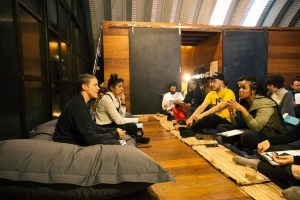
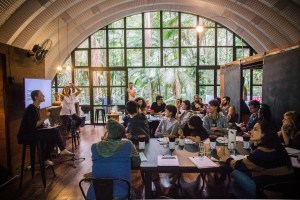
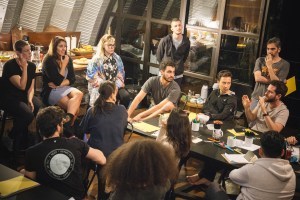
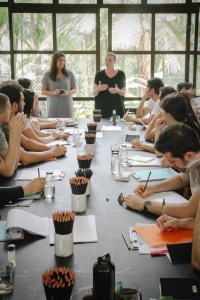
The premise
Here is the basic premise: the world is only getting more complex. This means there will be fewer and fewer proven solutions to problems. What we need is not a new and better solution, but a method for creating solutions quickly, in response to changing conditions.
At the same time, the most talented people are increasingly mobile, picky, and in demand. It is going to be ever more difficult to tie them down with full-time employment.
The only way to solve the world’s most complex challenges is by working with the best in the world. And the only way to do that is to keep the time commitment short, remove every obstacle to them creating value, and create an environment and a team where they can do the best work of their lives.
It was in pursuit of this vision that MESA was born.
The goal is to create a brief, but very intense working environment where a small group of carefully chosen participants can build something tangible to advance a mission or cause that they care about. The method takes advantage of rapid prototyping tools, software-as-a-service, and modular templates to build something real and functional that embodies the knowledge and experience of everyone at the table. This prototype is used not just to demonstrate the viability of a solution, but to build consensus around a new direction for the company.
The client is a “problem owner” responsible for an important challenge that they can’t solve on their own. Perhaps their main product is no longer resonating with a younger generation of consumers. Their marketing channels are outdated and obsolete, but they are afraid to cannibalize them with new ones. They could be tasked with revitalizing a product line in the face of major technological shifts. Or it could be a social mission, meeting the needs of an underserved population under tight budgetary constraints.
Whatever the problem, MESA is unique in that it is not primarily a service provided at arms’ length to a paying client. The MESA Co. team works with the client, not for the client. The problem owner and their team are the central participants in the process, which generates a level of trust and communication between clients and MESA leaders unlike what I have seen from agencies or consultancies. They had to demonstrate it again and again because it is so contrary to current thinking: taking the client at their word, not assuming or insisting that there must be a deeper problem that they aren’t aware of.
The structure
The overall structure of the week is fairly straightforward, and similar to other sprint methodologies.
Day 1 is a “download day” dedicated to getting all the relevant information out of everyone’s heads and “out on the table.” This includes the external participants, who were chosen for their specialized expertise in the industries, markets, and technologies thought to be most relevant.
On Day 2, the carefully worded “mission” is unveiled, drawing on the discoveries from the day before to frame the problem owner’s problem as an inspiring, yet feasible challenge. The second half of the day is spent generating a small set of ideas to prototype.

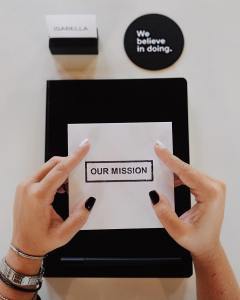

All photos are from the official MESA Instagram account
Day 3 is for prototyping, which includes small groups writing copy, making mockups or landing pages, building demos, or producing short videos or presentations to demonstrate the viability of the ideas from the day before. It is on Day 3, once people have to start making real tradeoffs in the making of the product, that the real constraints arise.
Day 4 is focused on more advanced prototyping, taking the most viable prototypes to a basic level of functionality. The leader pushes to bring the fidelity of the prototype as close to reality as possible, including real code and functional backends whenever possible. The further toward reality it moves, the more hidden constraints and priorities will come to the surface.
Day 5, the final day, is focused on wrapping up loose ends and preparing the final presentation. MESA Co. is adamant that the final deliverable cannot be just a presentation (or a report or briefing), but rather the presentation is a vehicle for delivering and explaining the prototype that was created. The presentation is ideally made to senior leaders of the company, or other stakeholders who will demand a high level of rigor. This is what creates a real sense of urgency and meaning around the deadline, and brings out the “productivity magic” of the last two days.
But where MESA shines is not in the explicit – the rules, structures, schedule, checklists – but in the tacit, the subtle, and the sublime. They have found a way to use these subtle touches not just to create a memorable experience, but to produce results that more heavy-handed methods can only dream of.
The experience
Why “mesa” (which means “table” in Portuguese)?


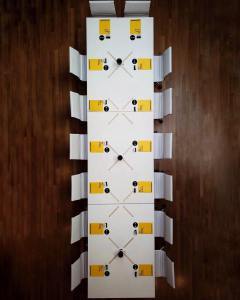
Because the table represents the intersection of pleasure and commitment. The pleasure of family and friends sitting together and sharing a meal in the evening. And the commitment of getting down to business, of giving everything you have to the task at hand.
Tables and the meals we eat on them are enveloped in rituals. From the way the table is set, to how the food is served, to how people sit and prepare themselves for eating, to how the food is actually eaten. Hundreds of these small rituals give us prescribed behaviors that we know will lead to the outcome we’re after – getting fed. They ensure we don’t disturb the experience of others, that we respect the host and the household, and that the food remains sanitary.
But there is a deeper purpose to these rituals that is easy to miss: they imbue the entire experience with significance. They make the process of getting calories into our bodies much more than the sum of its parts: an affirmation of our values, a time of connection with the people we love most, a reminder of what really matters at the end of a hectic day.
MESA seeks to reintroduce and translate some of these rituals to the world of work. But not just for nostalgic purposes. It recreates them from the ground up, focusing them like a laser on one thing: producing results. It is a reinvention of the rituals that once bound us together in a shared purpose, working toward a common cause, but adapted to the modern context.
The experience begins with the venue. MESA Co. very carefully chooses locations that support the results they are trying to produce. The venues almost always have a “wow factor” to inspire the participants with an environment that stimulates all the senses. Entering the venue as a group and seeing the meticulously laid out table gives you a sense of the gravity and importance of the mission you are about to undertake.



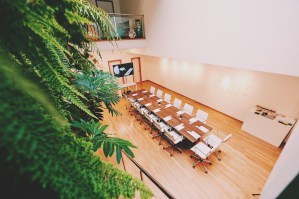

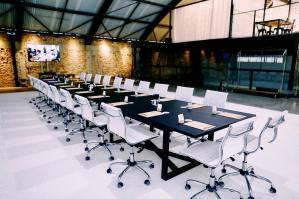
The table is, of course, central. It is laid out with precise measurements down to the centimeter, in order to put people just close enough to work together, while giving them enough space to work. Each place at the table has a name on it, like a wedding where every seating assignment is carefully chosen. The setting includes just the essential materials needed for the week, often including a notebook, pen, and bag. Even the color scheme is chosen with intention, often purposefully clashing with the client’s official colors to avoid the “business as usual” attitude.
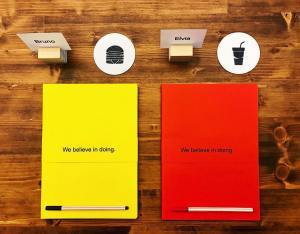


Every element in the space is chosen with intention: the chairs are comfortable for long hours of sitting and working; bags are collected in a central location so they don’t get in the way; the food is prepared simply and to avoid afternoon crashes; there are no clocks, giving the experience a sense of timelessness. My favorite touch is the “Leave Me Alone” wall – a grid of pockets with participants’ names on them, where everyone is asked to leave their phones to remove the temptation.

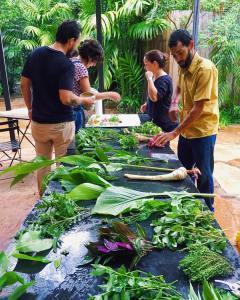

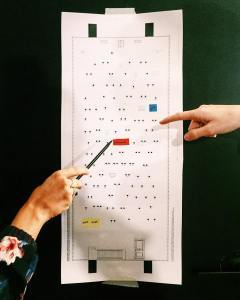
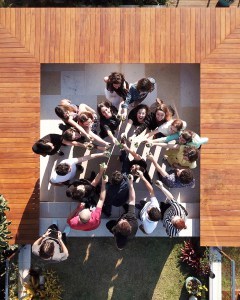

The real purpose of all these decisions and rituals is to change participants’ behavior, away from the counterproductive habits we’ve developed, and toward a more focused way of working that is rarely possible in a distraction-filled workplace. MESA changes behavior not with rules, but by changing the context. As you find yourself in an environment purposefully free of the usual triggers and hooks, with a full staff dedicated to protecting you from every distraction or discomfort, your creativity is unleashed. People respect rituals more than rules, because rituals give us something meaningful in return for our compliance.


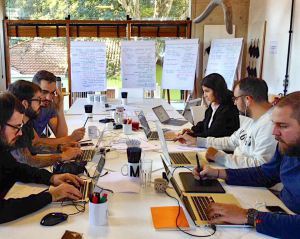
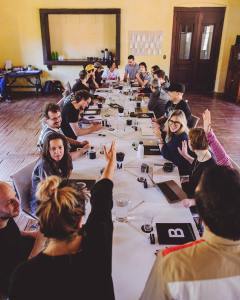
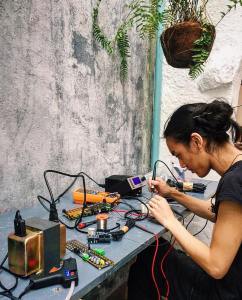
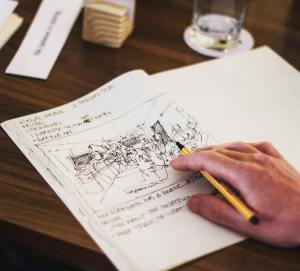
The context
Coming back to the everyday world, I’ve begun to notice a phenomenon everywhere: as soon as one person in a group takes out their phone or computer, everyone else is much more likely to do so as well. It only takes one person to check out for the atmosphere of human presence to start being sucked out of the room, like an airplane cabin with a punctured window. And once that air is gone, it’s very hard to bring people back.
A quick glance at your notifications seems so harmless, but it communicates something unmistakable to others: there is somewhere you’d rather be, mentally if not physically. Check your phone, and an invisible cocoon suddenly springs up around you. It is this cocoon that makes it hard to connect with the people around us, even after the phones are put away.
I believe that people naturally want to focus, but only if that focus will be protected and respected. They want to give their best, but only if that effort will be put to good use. As the idealism of wanting to do a good job collides with the fragmented reality of modern schedules, we become resigned, gradually coming to resent the environment that seemingly won’t allow us to excel. What I see among MESA participants is a sigh of relief, followed by an unbelievable explosion of creative energy. Every signal tells them that this is a place for focus, that their contributions are wanted and valued. When the internal and the external conditions align, it feels like anything is possible.
Now that you have the overall picture of what a MESA looks like, in Part 2 I’ll dive into what I believe are the underlying principles, and later we’ll look at how you can apply them to your own work. Enter your email here if you’re interested in hearing more or participating in a MESA in the future.
Subscribe to Praxis, our members-only blog exploring the future of productivity, for just $10/month. Or follow us for free content via Twitter, Facebook, LinkedIn, or YouTube.
The post Introducing the MESA Method: Creating the Ideal Work Experience appeared first on Praxis.
September 17, 2018
The Design of a Weekly Review
The most important practice that I recommend everyone adopt for their personal productivity is a Weekly Review – a regular reflection on their priorities and goals designed to give them a sense of clarity for the upcoming week.
Whether you adopt the Getting Things Done method or something else isn’t important. It doesn’t matter whether you do it every single week at the same time, or only occasionally as needed. It can be more philosophical and introspective, or detailed and specific. It’s up to you.
But this brings up the question of design. How do you choose what kind of review you should perform? How do you perform it? What are the steps? How do you know when you’re done?
These are all process design questions, and very few people are prepared to take them on. But without this practice, you’re never going to level up your productivity. In the same way you can’t level up your finances without regularly reviewing your budget.
The first step in designing a process is to decide what it’s for: what results or outcomes do you want the process to produce? Here are the intended outcomes I’ve decided on for my three reviews:
My Weekly Review is designed to give me just enough situational awareness to take effective action
My Monthly Review is designed to translate my long-term goals into current projects
My Annual Review is designed to redirect my time, effort, and attention toward a future of my own creation
In the previous articles in the Reviews series, I explained how I do my weekly, monthly, and annual reviews as examples. In this article, I’ll examine the fundamental design of each one and show how they are integrated across time to produce the results I want.
To read this story, become a Praxis member.

Praxis
You can choose to support Praxis with a subscription for $10 each month or $100 annually.
Members get access to:
1–3 exclusive articles per month, written or curated by Tiago Forte of Forte Labs
Members-only comments and responses
Early access to new online courses, ebooks, and events
A monthly Town Hall, hosted by Tiago and conducted via live videoconference, which can include open discussions, hands-on tutorials, guest interviews, or online workshops on productivity-related topics
Click here to learn more about what's included in a Praxis membership.
Already a member? Sign in here.
The post The Design of a Weekly Review appeared first on Praxis.
September 13, 2018
The Forte Labs Staff Retreat, 2018
In mid-August we held our first ever staff retreat, gathering 10 people in a house in the Oakland Hills to set the direction of the company for the next year. It was an opportunity to begin to answer the question: what is it that we stand for? What is Forte Labs’ role to play in the world, as a team and individually?
We are spread all over the country, and working together can sometimes feel abstract and impersonal. Our intention was to get to know each other better, forge a new identity as a team, and clarify our principles and values.
To read this story, become a Praxis member.

Praxis
You can choose to support Praxis with a subscription for $10 each month or $100 annually.
Members get access to:
1–3 exclusive articles per month, written or curated by Tiago Forte of Forte Labs
Members-only comments and responses
Early access to new online courses, ebooks, and events
A monthly Town Hall, hosted by Tiago and conducted via live videoconference, which can include open discussions, hands-on tutorials, guest interviews, or online workshops on productivity-related topics
Click here to learn more about what's included in a Praxis membership.
Already a member? Sign in here.
The post The Forte Labs Staff Retreat, 2018 appeared first on Praxis.
September 9, 2018
Emergent Strategy: Organizing for Social Justice
When I moved from San Francisco to Oakland in 2014, I was just trying to pay cheaper rent. I never expected to be influenced by the movements that flow through Oakland’s veins: the movements for social justice, for environmental justice, and for black liberation.
I’ve since had the privilege of working with some of the most extraordinary black leaders, organizers, and activists in the San Francisco Bay Area. Through the courses I’ve taken at Landmark, through local groups and events such as the East Bay Meditation Center, and through exposure to the network my partner Lauren has developed through UC Berkeley and the Greenlining Institute. I’ve stayed only on the furthest outskirts of this incredible community, but even that light exposure has profoundly changed how I think about my work.
It was through Lauren that I first heard of a book called Emergent Strategy, by adrienne maree brown. The title immediately caught my eye, echoing my interest in Emergent Productivity from several years ago. I began to hear about it through different channels, from different people, and could see this book was catching fire in the movement-building world.
I decided to read it, and found a new world of ideas and stories that were somehow both completely novel, and deeply familiar. I found a new language to talk about healing, growth, liberation, forgiveness, and change. I found a body of work bridging and connecting a stunning diversity of sources and fields, much like I try to do myself. But with a far stronger connection to what is happening on the ground, in the lives of people who don’t have access to the same resources and opportunities.
This is my summary and interpretation of the book, in the hope that it will reach more people who might not otherwise pick it up. I’m going to paraphrase in my own words, and incorporate some of my own experiences and learnings from the world of productivity and effectiveness. Assume all substantive ideas come from the book.
Emergent Strategy: Shaping Worlds, Shaping Change by adrienne maree brown
Adrienne maree brown is an author, activist, social justice facilitator, healer, and doula living in Detroit. She has been a part of many of the most significant social movements in recent years, including Black Lives Matter and Occupy Wall Street.
Her book is a summary and exploration of what she’s learned from her experiences as an organizational leader and facilitator. It’s not written at all like a typical non-fiction book. Paragraphs of meandering text are interwoven with poems, song lyrics, quotes, lists, and diagrams. She moves freely from the most concrete advice to the most philosophical ideas. Her influences include famous activist leaders like Grace Lee Boggs, but also the science fiction author Octavia Butler, ideas from biomimicry and permaculture, and popular culture and music.
Emergence and biomimicry
It all begins with the idea of emergence. Emergence to AMB is not an abstract concept from information science. She draws instead from nature – her examples include roaches, ants, deer, fungi, bacteria, viruses, bamboo, eucalyptus, squirrels, vultures, mice, mosquitos, and dandelions. She studies how mycelium grow underground in thread-like formations, gaining strength by connecting their roots to one another. She admires how ants and starlings are able to coordinate in large numbers and react to their environment by following simple, local rules. Ferns and their fractal patterns are the inspiration to look for small-scale solutions that propagate outward and impact the whole environment. Dandelions are admired for their extreme resilience, that they can thrive and spread despite being uprooted and trampled on.
Humans have traditionally identified most with the “kings” of the jungle, like lions. We aspire to be powerful as individuals, claiming a territory and defending our reputation. But Brown notes that despite their isolated ferocity and alpha power, it is these very animals that are going extinct as our climate changes. The resilience of more decentralized, interdependent life forms is that they adapt and collaborate, while maintaining core practices essential to their survival.
This model of emergence is practical instead of theoretical. It emphasizes “critical connections over critical mass” – it is the depth of relationships that determine the strength of a system. Brown’s definition of emergence comes from Nick Obolensky: “Emergence is the way complex systems and patterns arise out of a multiplicity of relatively simple interactions.” It is these “simple interactions” – from how we relate to the thoughts in our own heads, to how we show up in our relationships, to how we exist as local communities – that create the patterns that give rise to our ecosystems and societies.
From this perspective, deep systems change starts with shaping the smallest patterns of our daily lives. We can, in Brown’s words, “…intentionally change how we live in ways that grow our capacity to embody the just and liberated worlds we long for.” This is very much in line with my work, examining how the smallest and simplest of daily work practices, upon closer examination, unfold into fractal worlds of amazing complexity and depth. It is much faster and more effective to look for insights inside these worlds, then to go searching for an answer outside ourselves somewhere.
Brown is also, whether she knows it or not, a fan of compression. Here are her core principles of emergent strategy:
Small is good, small is all (The large is a reflection of the small)
Change is constant (Be like water)
There is always enough time for the right work. There is a conversation in the room that only these people at this moment can have. Find it.
Never a failure, always a lesson
Trust the People (If you trust the people, they become trustworthy)
Move at the speed of trust
Focus on critical connections more than critical mass—build the resilience by building the relationships
Less prep, more presence
What you pay attention to grows
These principles resonate deeply with what I’ve discovered in the world of personal effectiveness. Here is how I translate them:
Small is good, small is all (The large is a reflection of the small)
To find deep insights, look closely into the inner workings of how you manage your daily work, from how you manage email and your calendar, to how you decide what to work on next.
Change is constant (Be like water)
Invest in your capacity to adapt, expecting your work and your life to change, instead of trying to prevent them from changing.
There is always enough time for the right work. There is a conversation in the room that only these people at this moment can have. Find it.
Choosing what the work actually is, and with whom you will do it, has far greater leverage than how you perform it.
Never a failure, always a lesson
Every experience you have is fuel for creative inspiration. The bigger the failure, the better the fuel.
Trust the People (If you trust the people, they become trustworthy)
Learning how to trust people, and how to allow them to trust you, is a far greater source of leverage than all the productivity tips, tricks, and hacks ever conceived.
Move at the speed of trust
How fast you can move is determined by how much trust you have. And people won’t trust you unless you are vulnerable with them.
Focus on critical connections more than critical mass—build the resilience by building the relationships
A relationship to the right person can have more leverage than a large group agreeing. Invest in that relationship because it is critical.
Less prep, more presence
Preparation has diminishing returns after a while, while presence has exponential returns. The sooner you move from preparing to being present, the better your results will be.
What you pay attention to grows
Attention is the rarest and most precious resource we have. It can be shaped and cultivated by investing attention in the first place, in an endless cycle.
Science fiction as visionary fiction
From studying the deep past of the biological world, Brown shifts our attention to envisioning the future. Specifically, she dives into science fiction as a tool to help us see worlds that do not yet exist. One of the biggest influences on her work has been Octavia Butler, a black woman who wrote science fiction far ahead of her time.
She argues that:
“We are in an imagination battle. Trayvon Martin and Mike Brown and Renisha McBride and so many others are dead because, in some white imagination, they were dangerous. And that imagination is so respected that those who kill, based on an imagined, racialized fear of Black people, are rarely held accountable. Imagination has people thinking they can go from being poor to a millionaire as part of a shared American dream. Imagination turns Brown bombers into terrorists and white bombers into mentally ill victims. Imagination gives us borders, gives us superiority, gives us race as an indicator of capability. I often feel I am trapped inside someone else’s imagination, and I must engage my own imagination in order to break free.”
Brown embraces the tools of sci-fi to help paint a different picture of how the future could be. It’s not enough to make those futures plausible or realistic. Visions of dystopia are nothing if not plausible and realistic. We must also make just and liberated futures irresistible. I absolutely love this, as it aligns with all the research on behavior change. We don’t change our behavior out of shame, or punishment, or pressure, or even desire. We change out of pleasure and freedom and love. This is why Brown calls herself a “pleasure activist,” and I’m going to as well.
What’s so important to understand is that we aren’t trying to create a monolithic, homogeneous future. Brown notes that many sci-fi stories describe an antiseptic and boring future full of stark modern architecture and pervasive technology. It’s a future that few people would actually want to be a part of. Instead we need to equip everyone with imagination tools, so that they can create an abundance of futures, where everyone doesn’t have to be the same kind of person. As the Zapatistas say, “The world we want is one where many worlds fit.” The only way to break out of someone else’s imagination is to imagine ourselves into a new one.
Dialectical humanism and healing
As brilliant as these intellectual explorations are, where this book really shines is its exploration of the human heart. Brown returns to the idea of “dialectical humanism” that she learned from her mentor Grace Lee Boggs: that there is a cycle of collective transformation of beliefs that occurs as we gather new information and experiences, meaning that, over time, we can understand and hold a position we previously believed to be wrong.
This idea strikes to the heart of the modern age, where we each seem to be descending deeper and deeper into our private filter bubbles. The ability to change one’s mind seems to be the key capability we are losing as a society. Maybe we never had it. Boggs is quoted arguing that “…whenever a person or an organization or a country is in crisis, it is necessary to look at your own concepts and be critical of them because they may have turned into traps.” We are presented with fewer and fewer opportunities to do so in a world where we can increasingly hear only what we want to hear.
This is the point where an understanding of emergence is so critical. Often this topic leads to grand discussions of the state of our democracy, the role of social media and partisan politics, and blaming specific individuals or groups. I’ve always felt that this is an unproductive level to focus on, at least for me and my work, and Brown gives me the words to understand why: the trends we are seeing in the world are the result of simple, local interactions. They arise inexorably from who we are being in our private thoughts, in our relationships, and in our communities.
This has helped me understand the role of healing, which I’ve always been uncomfortable with. My story has been that I never had any real trauma growing up, at least compared to most people I know. Why should I have anything to heal? I saw healing as a process of remediation, of getting “back to normal.” And didn’t feel I deserved the luxury. Even as I’ve had experience after experience that can only be described as healing, I’ve resisted the idea that everyone can or should pursue it.
But Brown offers a series of reframings for what healing actually is that I find tremendously empowering.
First, healing is not “fixing oneself.” It is the re-opening up of the parts of ourselves that have closed. They closed for good reasons, to help us survive. We honor those experiences and those decisions, while gently inviting those parts to open up once again. Like a child who used to throw tantrums to get their way, but now has the words to say what they need. It can take us a while to exercise this newfound ability.
Second, healing is painful, but not as painful as continuing to ignore it. I think often we think that the healing process will be as painful or more painful than the thing that originally hurt us. But healing is, in fact, always occurring. It is a natural phenomenon of the human heart, and therefore we need only embrace it and let it proceed. Paul Ferrini says that “Your life is your spiritual path. Don’t be quick to abandon it for bigger and better experiences. You are getting exactly the experiences you need to grow. If your growth seems to be slow or uneventful for you, it is because you have not fully embraced the situations and relationships at hand. To know the self is to allow everything, to embrace the totality of who we are—all that we think and feel, all that we fear, all that we love.”
Lisa Thomas Adeyemo says that “Everything, given time and nurturing, is moving toward balance and healing. The mushrooms that cleaned the land after nuclear trauma…the process of forest growth after a fire…the way our skin heals after a cut…stronger than before. Healing is organic, healing is our birthright.”
Third, that healing opens up tremendous capacity to think, to feel, and to know. It unlocks vast new channels for creating the life we want to live, and for impacting others. This is why social impact and personal growth are so intertwined. You cannot create change that you yourself have not experienced. You cannot create freedom for others via your own suffering. You are a seed, and that’s not how seeds work. When you open yourself up to the lessons that life is trying to teach you, new things start to flow: truth, comfort, ease, joy, wholeness, acceptance. These things are not achievements far out on an endless horizon. They are waiting at the intake valve, ready to arrive the moment you allow it.
And fourth, that healing is not a linear, one-way process. It’s not that everything gets better and easier and happier all the time. Healing is not synonymous with self-improvement. Brown asks us to consider a bold series of propositions:
That the broken heart can cover more territory
That perhaps love can only be as large as grief demands
That grief is the growing up of the heart that bursts boundaries like an old skin or a finished life
That grief is gratitude
That water seeks scale, that even your tears seek the recognition of community
That the heart is a front line and the fight is to feel in a world of distraction
That death might be the only freedom
That your grief is a worthwhile use of your time
That your body will feel only as much as it is able to
That the ones you grieve may be grieving you
That the sacred comes from the limitations
That you are excellent at loving
In other words, taking on the work of healing involves more heartbreak, and more grief. Feeling more involves feeling more in all dimensions, including the ones you’re not currently comfortable with. It involves losing control of what you allow yourself to feel. This is why it’s scary sometimes.
Returning to her work in movement-building, Brown says that change doesn’t come simply from thinking differently. This is the deep misconception at the heart of self-improvement. That you can just think different thoughts, thoughts you read in a best-selling book or online course, and that everything else will unfold automatically from there.
It isn’t true. The factual learning is necessary, but only as a staging ground. Change actually occurs through direct experience, doing exactly the thing you are scared to do, which allows you to shift what you are capable of understanding, what you are capable of feeling, and what you are capable of practicing. Change emerges from the correlation between feeling more, and having more choices.
Building movements
The book rather unexpectedly becomes a how-to on “How to Build a Movement.” Brown has an unapologetic practical bent, which I appreciate.
She starts with what the current paradigm teaches, in our homes, in our schools, in our organizations, and in society:
That we should deny our longings and skills, in favor of work that fills hours without inspiring our greatness
That tests and deadlines are the reasons to take action, which favors people with good short-term memories and who respond well to pressure, who become leaders who depend on urgency-based thinking even when it’s not required
That we need to compete with each other in a scarcity-based economy that destroys the abundant world we actually live in
That the most valuable skills involve being able to manipulate and sell to each other, instead of learning and collaborating
That the natural world is to be manicured, controlled, or pillaged to support our consumerist lives (including the natural lives of our own bodies)
That factors beyond our control – our skin color, gender, sexuality, ability, nation, or belief system – determine our path and quality of life
That we are valued only to the extent we can produce – only then do we deserve food, home, health care, and education
That our success is measured in financial results, regardless of its impact on others and the environment
That we should swallow our tears and any other inconvenient emotions
That we should just be really good at what’s already possible, and to leave the impossible alone
But Brown’s criticism is not reserved for “the powers that be.” She turns next to social impact organizations, who so often replicate the very same power structures they claim they are trying to dismantle. They often have singular, charismatic leaders, top-down hierarchies, money-driven programming, destructive methods of engaging conflict, unsustainable work schedules, and a lack of accountability to prove they are having the impact they claim.
This is why nonprofits can have the most challenging and destructive work cultures, characterized by burnout, overwork, underpay, unrealistic expectations, personal drama, movement splitting, mission drift, and the inability to make decisions.
I’ve experienced these patterns firsthand. Most of my career was spent trying to “do good.” Teaching English in the favelas of Rio de Janeiro, working in microfinance in Colombia, teaching leadership and community service in the Peace Corps. I ultimately left because, more often than not, these organizations had the best of intentions but lacked effectiveness. They simply couldn’t accomplish what they set out to accomplish, and the aura of social impact shielded them from any scrutiny that might have changed things. I moved to business, where results were measured and companies were at least sensitive to one source of feedback – their customers.
I so admire Brown’s insistence on taking personal responsibility for how these events play out. She tells story after story of her raging individualism, her challenges in staying connected to her body and spirit, and resistance to leaning on others. Like me, she is naturally brainy and self-reliant, yet has come to realize that these wonderful qualities are simply not going to be the important ones moving forward.
She says: “I am socialized to seek achievement alone, to try to have the best idea and forward it through the masses. But that leads to loneliness and, I suspect, extinction. If we are all trying to win, no one really ever wins.”
And continues: “I have to use my life to leverage a shift in the system by how I am, as much as with the things I do. This means actually being in my life, and it means bringing my values into my daily decision making. Each day should be lived on purpose. This has meant increasing my intentionality about being with others. Adapting to the changes of life, yes, but with a clear and transparent intention to keep deepening with my loved ones and transforming together…I am living a life I don’t regret. A life that will resonate with my ancestors, and with as many generations forward as I can imagine.”
The banner she flies is a quote from Albert Camus, given special meaning as a black woman: “The only way to deal with an unfree world is to become so absolutely free that your very existence is an act of rebellion.”
What building a movement requires
So what does it take to successfully build a movement, with ourselves as the starting point?
Being seen
It is all too easy to project our desire for change onto the outside world. To seek to fix others as a way of avoiding fixing ourselves. It was this impulse that drove me for years.
Which is why the first step is allowing yourself to be seen. And to be known. It is being seen and accepted as whole beings that begins the healing process. It begins to release our resistance to loving ourselves exactly as we are, right now. Which allows us to love those around us, just as they are. Instead of making our love contingent on something, or withdrawing it as a threat.
The modern world gives us so many ways of not being seen, including allowing only part of ourselves to be seen. It takes great courage to put down the social media handles, to allow the flattering frames to fall away, to show up and to be vulnerable when we feel most at risk. There are always moments of trauma and loss of control where we have no choice but to be seen. But we have the choice to make it a way of living, to do it on purpose.
When you allow yourself to truly be seen, an amazing thing happens: you realize that your very existence, who you are, is in itself a contribution to those around you. Not what you do or what you produce, but just your presence. Have you ever heard a more radical idea? We are taught that love is about belonging exclusively to one person or community. That therefore we must contort ourselves in order to ensure continued belonging. We are taught that our value comes from what we produce, and that certain emotions impede production. Vulnerability is the fundamental reversal of this logic.
Brenda Salgado writes: “Nature has taught me so much about moving with the seasons, that we need to honor times of harvest and times of rest. That the frenetic pace of doing, doing, doing, without being present with each other and the season we are in, what is happening around us, is unnatural and counter to life. So it has made me realize how important community ceremony and celebration is to our efforts to transform the world.”
Being wrong
A friend of mine has a Post-it note in the corner of his laptop that says: “Be wrong more.” I love that. As a thinker, I am addicted to being right. Like any addict, I will burn relationships to the ground if I can have just a little bit of “being right.” I’ll leave communities, betray my values, and justify it all with my self-righteousness, as if my very survival depended on it.
Brown describes her experiences with leadership, how the ability to be wrong and then to quickly pivot her position is key to her ability to lead. I’ve found much the same thing. That the longer I wait before releasing my viewpoint, the more painful and heavy the experience of life becomes. Often this begins with just naming something, pointing out a pattern that is present in my family or the company before I know the cause or the solution. This feels risky, because more often than not the cause is me, and the solution is not-me.
Brown notes that the capacity to be wrong allows you to be in relationship in real time, instead of defending the past. She asks us to consider that “…the place where you are wrong might be the most fertile ground for connecting with and receiving others.” If you are not able to be wrong, you can’t access this most fertile ground.
Art
Art is also a critical component of building a movement. Brown notes that “Art is not neutral. It either upholds or disrupts the status quo, advancing or regressing justice.”
She recounts the teachings of her meditation teacher, Black Zen teacher angel Kyodo williams: that our access to the global scale of suffering has become immediate, through technology, but we have not developed the capacity to be with that increased awareness of suffering. In her meditation retreats, Williams teaches people how to choose where their attention goes. When overcome with grief, sadness, loss, desire, anger, or restlessness, to really be with those emotions, and to sense what is needed.
This is where our work crosses paths most clearly. I find it very curious that the word “organizing” is used primarily in two contexts: organizing physical spaces or computer files, and organizing people in social movements. Maybe this isn’t a coincidence. What they have in common is that they involve “Organizing and fortifying ourselves so that we can source from our longings, health, love, dreams, and visions, from our strength and our connections with each other.”
Being organized, in both senses, involves arranging your environment so that you have ready access to the greatest resources at your disposal. It involves clearing away what is obscuring your vision and your movement, making hard decisions about what matters and what doesn’t, distinguishing between what you can control and what you can’t, and acting with more elegance and power. The heart of efficiency is that there is nothing dragging or diverting the energy of the work. From digital files to physical spaces to people, there are ways of making it vastly easier and more enjoyable to move in the direction we want. And what is easy and enjoyable is sustainable.
Cultivating small practices
The ground level of emergent strategy is made up of small practices we integrate into our daily lives, which draw the patterns that metastasize into the structure of society.
Brown lists the practices that she has integrated along her own path: “meditation, somatics, visionary fiction, facilitation, working out, yoga, intimate community on social media, check ins with woes (those who are also Working on Excellence) and buddies, orgasmic meditation, sex, self-documentation (self-love selfies! Learning to see beauty and power in my standard breaking appearance), sugar shifting, sabbatical (big one in 2012, annual mini-sabbaticals since then), poetry, unscheduled time, moon-cycle rituals, tarot (I am such a fan of this practice that I have bought five other people tarot decks), sage and frankincense cleansing of my home, journaling.”
The key words, I think, are “integration” and “practice.” You can attend a weekend training or retreat that introduces you to a new practice. But it is the regular routine that gives it power. Notice that tightening feeling in your chest? Being willing to try on new practices in such a fluid and unattached way requires releasing the high stakes game of success vs. failure we often adopt when it comes to “habit formation.” Maybe you’ll stick with the new practice, and maybe you won’t. Over the years I’ve discarded far more than I’ve adopted. And many are appropriate only for a season of life, and after that can fall away.
Deep, slow, intentional work
I found this fascinating: that Brown traces many of our current challenges back to “urgency-based thinking.” This involves approaching everything as an urgent problem requiring extraordinary measures, and seeking quick fixes instead of addressing the root of the problem.
Changing the economic or political system won’t magically fix the situation. So often these systems are alternatives in name only, and amount to changing the window dressing. More fundamental is the aura of scarcity that pervades so much of our thinking: not enough, not good enough, not fast enough, not big enough.
The real alternative is to take on the deep, slow intentional work of personal growth. This work is messy as hell: letting go of our stories, taking responsibility for our lives, giving up our pride and ego and self-righteousness. This work isn’t glamorous, doesn’t give you status points, and never ends.
But it opens up tremendous new capabilities for speaking, listening, and being with each other. As we expand our capacity to feel our bodies, we become more honest, because the body never lies. As we heal our wounds, certain forms of hierarchy naturally fall away, as people realize they don’t have to consent to it. Other forms of status remain as people realize it is not a threat. Brown says, “When we can stand in knowing another person’s power without feeling threatened, that can be powerful in itself…Being able to really see another person’s expertise without being upset by it.”
In parting
It is comforting for me to realize that the societal transformation described above is inexorable. Yes, it depends on us. But it also doesn’t. I always remind myself, when things get too weighty and dramatic, that it’s all just the laws of thermodynamics at work. We are the ones who add the meaning and the emotion.
This movement of movements can be seen as just the next stage of our evolution. Richard Strozzi-Heckler writes, “The evolutionary thrust surges through us as dreams, sensations, longings, images, and inexplicable utterances and gestures. We are constantly adapting, creating, filling, emptying as we become the dream.”
Removing the sense of personal risk opens up this moment in history as an opportunity. Something is going to happen, and our choice is in what part to play. We can be the friction, or we can be the flow. We can withhold our ideas and our energy, or we can share them.
The amazing thing is that there is room for every single person’s contribution. When we share our ideas, they become more complex, more interesting, and more likely to work for more people. When we share our ideas, they become bigger than ourselves, which means they also become bigger than our fears, our doubts, and our insecurities.
My question for you is, “What are you embodying in your work and in your life?” Given that you are a seed of the future, what are you a seed of?
Loretta Ross teaches us that, “When people think the same idea and move in the same direction, that’s a cult. When people think many different ideas and move in one direction, that’s a movement.”
What are you sharing? And which movement are you sharing it with?
Subscribe to Praxis, our members-only blog exploring the future of productivity, for just $10/month. Or follow us for free content via Twitter, Facebook, LinkedIn, or YouTube.
The post Emergent Strategy: Organizing for Social Justice appeared first on Praxis.
September 2, 2018
The Personal Narrative Vision
In my previous article on how I perform my Annual Review, I briefly discussed the Personal Narrative Vision (PNV) exercise. I’ve developed the PNV by drawing on many other visualization exercises I’ve encountered over the years, synthesizing them into a simple yet profound writing exercise.
The PNV is one of the most important but also least structured exercises I perform. It is like a blank canvas, allowing me to paint a picture of a desired future without constraints or boundaries. I don’t use any particular guidelines or rules myself. The only instruction is to write, in present tense, a detailed description of what my life will look like in one year. It doesn’t need to be feasible or even realistic.
Because there is no checklist, the only way to demonstrate what it looks like is simply to show you my own.
To read this story, become a Praxis member.

Praxis
You can choose to support Praxis with a subscription for $10 each month or $100 annually.
Members get access to:
1–3 exclusive articles per month, written or curated by Tiago Forte of Forte Labs
Members-only comments and responses
Early access to new online courses, ebooks, and events
A monthly Town Hall, hosted by Tiago and conducted via live videoconference, which can include open discussions, hands-on tutorials, guest interviews, or online workshops on productivity-related topics
Click here to learn more about what's included in a Praxis membership.
Already a member? Sign in here.
The post The Personal Narrative Vision appeared first on Praxis.
August 27, 2018
New Book: Extend Your Mind
I recently published my new ebook, a compilation of 19 Praxis posts from 2017, on the Amazon Kindle store.
[image error]
Click here to view it on Amazon
Read the Foreword below
Foreword from Extend Your Mind
This book is made up of 19 essays (or long-form blog posts) published in 2017 on the Praxis blog.
2017 was the first year we began charging for access to certain articles as part of a new monthly membership program. This meant that I had to stick to a consistent publishing schedule for the first time, which was quite a challenge. I found I had to create new habits and systems to make sure I was researching, reviewing, and sharing my ideas at a regular pace.
In January of 2017 I launched Building a Second Brain, an online course teaching people how to create such habits and systems for themselves. It quickly became apparent that these methods were not just useful for writers and content creators. Virtually everyone has a need to capture their knowledge, and move it through a series of steps to produce results.
The articles in this collection represent the research and development process I went through to develop Building a Second Brain. It contains summaries and dissections of influential books I wanted to incorporate at a deep level. It contains explorations of how ideas from engineering, telecommunications, manufacturing, evolutionary theory, sports instruction, art history, and other fields might teach us something about knowledge management. It also includes stories of my own personal learning process trying to develop these ideas while running a business.
The chapters in the Table of Contents are listed alphabetically, if you’d like to follow the evolution of the ideas through time. Below you will find the same chapters broken down by the purpose they served in my research process.
Borrowing ideas from engineering, manufacturing, and telecommunications
Bending the Curves of Productivity is an examination of “small-batch” productivity, and how working in short sprints can dramatically improve our effectiveness and enjoyment
From Multitasking to Multiplexing: 5 Steps to Building a Personal Productivity Network describes the fascinating parallels between telecommunications networks and personal productivity, specifically, how we can potentially increase our bandwidth by 100x using networks
Models I developed for the future of learning and working
The Future of Online Learning is my take on how online education will evolve in coming years, to become more intimate, intensive, time-limited, and experiential. Many of these ideas came to life in later versions of the Building a Second Brain course
The Rise of the Full-Stack Freelancer is my model for the future of work – that people will manage portfolios of income streams that give them income security along with flexibility and mobility
The Rise of the Full-Stack Freelancer, Part II: The Stack is a description of the digital products and services that I use as a Full-Stack Freelancer, as an example of how affordable and scalable the model can be
The psychology and inner experience of modern knowledge work
A Theory of Unlearning: Ecstasis, Anamnesis, Kenosis is my dissection of the book Stealing Fire by Jamie Wheal and Steven Kotler, looking at how immersive experiences and altered states of mind can be used to unlearn limiting beliefs and behaviors
Mood as Extrapolation Engine: Using Emotions to Generate Momentum is my theory of how to structure work – as a series of accelerating small wins – to produce motivation when we most need it
The Inner Game of Work: Focus, Desire, and Working Free is my summary of the book The Inner Game of Work, by Timothy Gallwey, exploring the psychological aspect of high performance and how to remove blocks to our natural, intuitive learning
The Topology of Attention is my take on the nature of attention, how it works, and why it’s so important to understand and shape it to create the experience we want
Extended cognition and how the environment influences how we think
The World Beyond Your Head: How Distraction Shapes Who We Are is my summary of the book The World Beyond Your Head by Matthew B. Crawford, in which he makes the case that our digital environment is shaping the way we think and thus who we are at a deep level, and argues for a return to tangible skills and communities of practice
Supersizing the Mind: The Science of Cognitive Extension is my dissection of the book Supersizing the Mind by Andy Clark, in which he lays out the core principles of the emerging science of extended cognition
History and broader context of personal knowledge management
Getting Things Done + Personal Knowledge Management is my explanation of how these two methods are perfect complements, working together to allow an individual to manage all the information coming their way and profoundly transform their effectiveness
Masters of Creative Note-Taking: Luhmann and Da Vinci tells the story of two master note-takers from history, German sociologist Niklas Luhmann and Italian Renaissance artist Leonardo da Vinci, and how they managed their note collections
Personal growth and how it relates to effectiveness
The Throughput of Learning is a philosophical essay originally published on the Ribbonfarm blog, in which I argue that revealing mistaken assumptions is the deeper purpose of learning, borrowing ideas from the Toyota Production System and the Theory of Constraints
Strategically Constrained: How to Turn Limitations Into Opportunities is my dissection of the book A Beautiful Constraint by Adam Morgan and Mark Barden, looking at how failures and limitations can be turned into strategic advantages, for individuals and companies alike
A Productivity Expert Goes to Burning Man is my account of my first experience at Burning Man, a temporary city and arts festival erected in the Nevada desert every year
Practical methods for automating productivity
The Weekly Review is an Operating System is a summary of my weekly review checklist, developed over years of trial and error
The Monthly Review is a Systems Check is a summary of my monthly review process, including a checklist template you can use to design a review of your own
The Annual Review is a Rearchitecture is a summary of my annual review, including the big picture questions I ask myself at the end of each year to guide the upcoming year
Thank you for your support, and for allowing me to share so much of my behind-the-scenes process. The past year has been an incredible journey in pursuit of a “second brain,” and it is my greatest privilege to be able to spend my time helping others begin that journey themselves.
Tiago Forte
Oakland, CA
August 7, 2018
Subscribe to Praxis, our members-only blog exploring the future of productivity, for just $10/month. Or follow us for free content via Twitter, Facebook, LinkedIn, or YouTube.
The post New Book: Extend Your Mind appeared first on Praxis.



